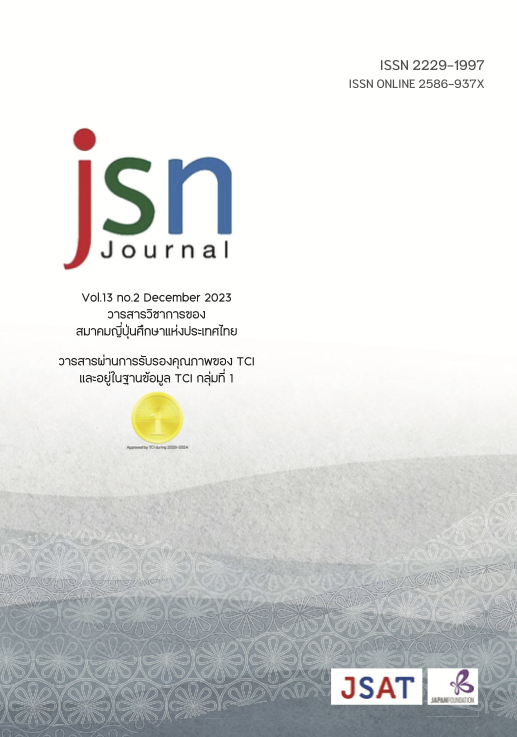การวิเคราะห์เปรียบเทียบชนิดของคำและปัจจัยในการเลือกใช้ชนิดของคำแทนตัวคู่สนทนาในภาษาญี่ปุ่นและภาษาไทย
Main Article Content
บทคัดย่อ
งานวิจัยนี้มีวัตถุประสงค์เพื่อศึกษาเปรียบเทียบชนิดของคำแทนตัวคู่สนทนาและวิเคราะห์ปัจจัยที่มีผลต่อการเลือกใช้คำแทนตัวคู่สนทนาในภาษาญี่ปุ่นและภาษาไทย ข้อมูลที่ใช้ในการวิเคราะห์มาจากเรื่องสั้นต้นฉบับภาษาไทยและฉบับแปลภาษาญี่ปุ่น ผลการศึกษาพบว่า คำแทนตัวคู่สนทนาที่พบในภาษาไทยมากกว่าภาษาญี่ปุ่น ได้แก่ ชื่อเฉพาะ คำนาม/นามวลี คำสรรพนามบุรุษที่สองและคำเรียกญาติซึ่งเป็นคำแทนตัวคู่สนทนาที่มีลักษณะเป็นการเรียกคู่สนทนาโดยตรงและมีระดับการก้าวล่วงเข้าไปในอาณาเขตของคู่สนทนาสูง ในขณะที่คำแทนตัวคู่สนทนาที่พบในภาษาญี่ปุ่นมากกว่าภาษาไทย ได้แก่ คำบ่งชี้และการไม่ปรากฏคำแทนตัวคู่สนทนาซึ่งเป็นคำแทนตัวคู่สนทนาที่มีลักษณะเป็นการเรียกคู่สนทนาโดยอ้อมและมีระดับการก้าวล่วงเข้าไปในอาณาเขตของคู่สนทนาต่ำหรือไม่ได้เข้าไปในอาณาเขตของคู่สนทนาเลย จากผลการศึกษากล่าวได้ว่าระดับความตรง-อ้อมของคำแทนตัวคู่สนทนาแต่ละชนิดซึ่งสัมพันธ์กับระดับการก้าวล่วงเข้าไปในอาณาเขตของคู่สนทนาเป็นหนึ่งในปัจจัยที่ทำให้การเลือกใช้ชนิดของคำแทนตัวคู่สนทนาในภาษาญี่ปุ่นและภาษาไทยแตกต่างกัน
Article Details

อนุญาตภายใต้เงื่อนไข Creative Commons Attribution-NonCommercial-NoDerivatives 4.0 International License.
ข้อความและข้อคิดเห็นต่างๆ ในบทความเป็นของผู้เขียนบทความนั้นๆ ไม่ใช่ความเห็นของกองบรรณาธิการหรือของวารสาร jsn Journal
เอกสารอ้างอิง
กนก รุ่งกีรติกุล. (2552). เปรียบเทียบความถี่ในการใช้คำสรรพนามบุรุษที่ 1-2 ในภาษาไทยและภาษาญี่ปุ่น-วิเคราะห์จากนว นิยายต้นฉบับและฉบับแปล-. เอกสารหลังการประชุม Conference on ‘East Asia Studies’ Bangkok, 26, 263- 282.
กนก รุ่งกีรติกุล. (2555). เปรียบเทียบความถี่ของการปรากฏและไม่ปรากฏคำสรรพนามแทนตัวผู้พูดและคู่สนทนาในภาษา ไทยและภาษาญี่ปุ่น-วิเคราะห์จากหนังสือการ์ตูนญี่ปุ่นต้นฉบับและฉบับแปลภาษาไทย-. เอกสารหลังการประชุม วิชาการระดับชาติเครือข่ายญี่ปุ่นศึกษาในประเทศไทย ครั้งที่ 5 (มนุษยศาสตร์), 5, 151-169.
กาญจนา นาคสกุล. (2540). คำสรรพนามในภาษาไทยสะท้อนวัฒนธรรมไทย. จดหมายข่าวราชบัณฑิตยสถาน, 7(73), ค้นเมื่อ 19 สิงหาคม 2565, จาก http://legacy.orst.go.th/?knowledges=คำสรรพนามในภาษาไทยสะท้e.
เมธินี อังศุวัฒนากุล. (2560). คำเรียกขานที่ใช้ในความสัมพันธ์แบบคู่รัก. (วิทยานิพนธ์ศิลปศาสตรมหาบัณฑิต). มหาวิทยาลัย ธรรมศาสตร์, กรุงเทพมหานคร.
ร้อยแก้ว สิริอาชา. (2562). การเปรียบเทียบการใช้คำแทนตัวคู่สนทนาในภาษาญี่ปุ่นและภาษาไทย-กรณีศึกษาในเรื่องสั้นญี่ปุ่น แปลไทย-. เอกสารหลังการประชุมวิชาการระดับชาติ ครั้งที่ 13 สมาคมญี่ปุ่นศึกษาแห่งประเทศไทย “จากเฮเซ สู่ เร วะ”, 13, 97-117.
สำนักงานราชบัณฑิตสภา. (2560). พจนานุกรมศัพท์ภาษาศาสตร์ (ภาษาศาสตร์ทั่วไป) ฉบับราชบัณฑิตสภา. กรุงเทพมหานคร: เอบิช อินเตอร์กรุ๊ป.
Barke, A. & Uehara, S. (2005). Japanese pronouns of address: Their behavior and maintenance over time. In R. Lakoff & S. Ide (Eds.), Broadening the Horizon of Linguistic Politeness (pp. 301- 313). Amsterdam: John Benjamins.
Ratitamkul, T., Siriacha, R., & Uehara, S. (2022). A parallel corpus study of referential forms in Japanese and Thai. In C. Shei & S. Li (Eds.), The Routledge Handbook of Asian Linguistics (pp. 548-565). Oxon: Routledge.
石黒圭 (2013). 『日本語は「空気」が決める 社会言語学入門』 東京: 光文社.
ケェンチャック,カノックポーン (1989). 「タイ語と日本語の人物呼称の用法に関する対照研究」 『待兼山論叢』 23, 61-78.
鈴木孝夫 (1973). 『ことばと文化』 東京: 岩波書店.
滝浦真人 (2008). 『ポライトネス入門』 東京: 研究社.
三上直光 (1981).「現代タイ語の呼称詞」『慶応義塾大学言語文化研究所紀要』13, 119-136.
三輪正 (2005).『一人称二人称と対話』 東京: 人文書院.


